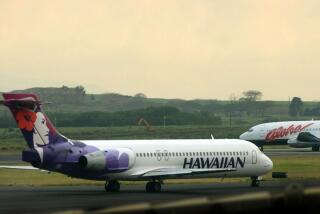American-US Airways merger would hurt consumers, report says
- Share via
American Airlines and US Airways are, after some battling, now both publicly open to merging.
But a new report warns that such a merger, which would result in the nation’s largest airline, could be bad for consumers because it might reduce competition, create strongholds at key airports and lead to higher fares.
The nonprofit think tank American Antitrust Institute in Washington and the Business Travel Coalition, which represents company travel managers, co-produced the report that will be released Wednesday.
“A US Airways-American combination poses potential concerns for competition and consumers,” said Diana Moss, vice president of the institute and co-author of the report with Kevin Mitchell, chairman of the travel manager’s coalition.
The two groups were careful to say that they don’t oppose a merger, but they wanted to point out possible consequences.
American Airlines, the nation’s fourth-largest carrier, has been the subject of merger rumors since its parent company, AMR Corp, filed for bankruptcy in November. US Airways, the nation’s fifth-largest airline, has made no secret that it would be interested in a merger and has gotten support for one from American Airline’s largest labor unions.
AMR, which had been on record as opposing a merger, changed its tune last month when its chief executive said the company would consider it.
An AMR spokesman declined to comment on the report by the two groups.
Scott Kirby, president of US Airways Group Inc. in Tempe, Ariz., said he had not read the report but dismissed suggestions that the proposed merger would hurt consumers.
Instead, he said, the merger would help US Airways and American Airlines better compete against bigger carriers such as Delta and United airlines, thus giving consumers more options for air travel.
“We are two complementary airlines that will make each other stronger,” Kirby said.
If the merger takes place, US Airways also vowed to continue serving nine airports — including Bob Hope Airport in Burbank — that American stopped serving in the last year.
If American and US Airways come together, the resulting airline would control about 20% of market share, followed by Southwest with 18%, United with 17% and Delta with 16%, the report from the antitrust group and travel managers said.
Combined, the four airlines would control more than 70% of the national market, according to the report.
The report also said US Airways and American offer overlapping service on 22 routes, including flights to and from Los Angeles International, Phoenix Sky Harbor International, Dallas-Ft. Worth International, Chicago’s O’Hare International and New York’s La Guardia airport, among others.
The merger would create a monopoly or near monopoly on some of those routes, leading to “adverse competitive effects, including increases in fares, reduction in service, and loss of choice,” the report said.
But Kirby argued that the two airlines complement each other, with US Airways prevailing in the East Coast and American strong in Chicago and Dallas. “There is no airport where we would dominate,” he said.
Jan Brueckner, a UC Irvine economics professor, said he and his colleagues at the university have studied the effects of a hypothetical merger between US Airways and American and predicted a minimal effect on fares.
“I don’t think anybody needs to worry about this merger,” he said. “It just makes sense.”
Brueckner added that most of the pressure that larger carriers face to keep fares low comes from low-cost airlines, such as Southwest Airlines, which recently bought AirTran Airways in Orlando, Fla.
More to Read
Sign up for The Wild
We’ll help you find the best places to hike, bike and run, as well as the perfect silent spots for meditation and yoga.
You may occasionally receive promotional content from the Los Angeles Times.






